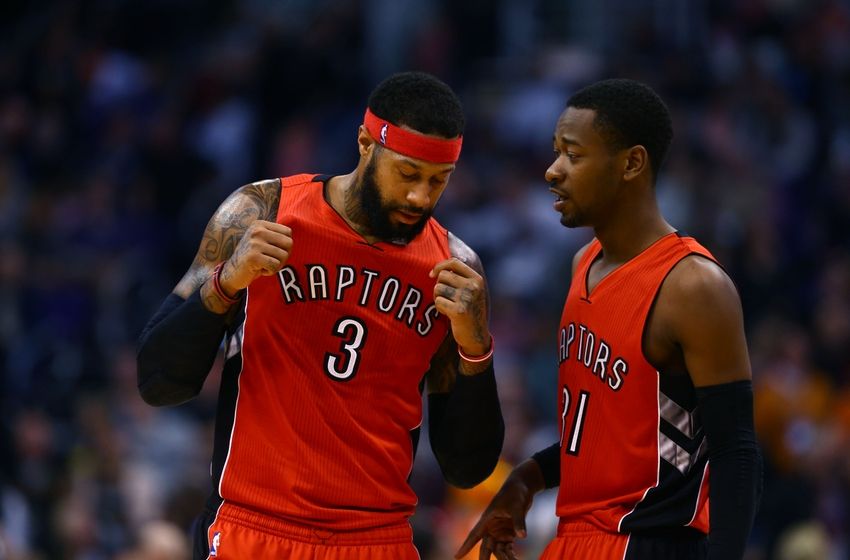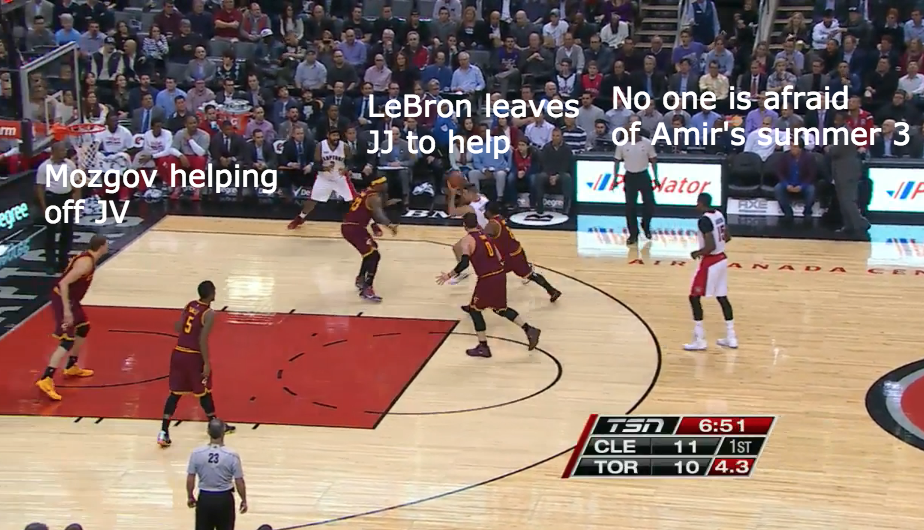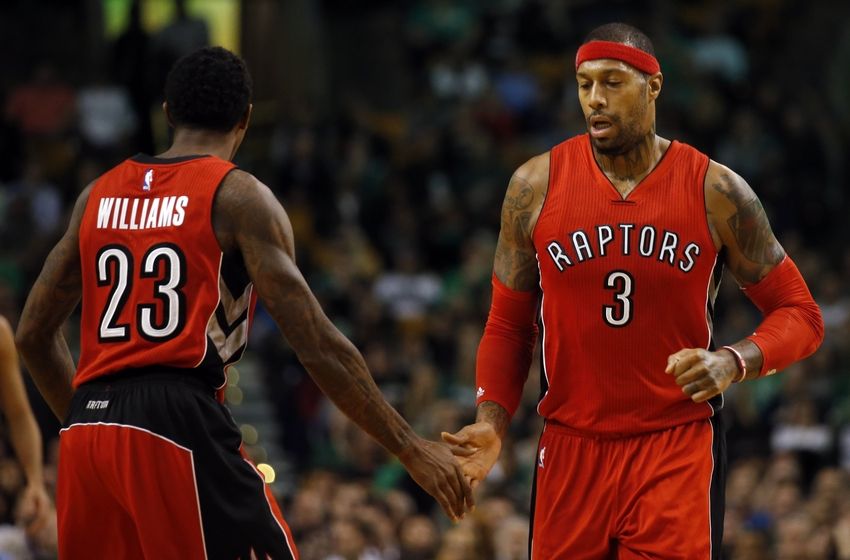For the second time this season, James Johnson is out of the rotation.
In two stints as a Raptor, James Johnson has been both the vilified pariah and the celebrated folk hero. Johnson famously butted heads with Dwane Casey in his first time around with the franchise, which ended in a trade. Then, this offseason, after the Raptors were carved up by Joe Johnson in the postseason, James Johnson returned to take up the role of designated wing stopper.
When he signed this offseason, Johnson carried the reputation of an embattled talent who needed to be carefully deployed in to be effective. Instead, Johnson has been a pleasant surprise. He’s still a gamble-heavy wing defender, eager to jump at closeouts, but his decision-making on offense has been purely team-first. On a team stacked with isolation scorers, Johnson has selflessly elected to take a backseat. He’s one of the sounder decision-makers on the Raptors (which is a terrifying thought).
Offensively, Johnson has been more Slim Charles than Marlo Stanfield — he’s been happy to sit back and take the profit off the top. He’s no longer going rouge and calling his own number. That has translated to the best shooting numbers of his careers. Johnson is averaging 8.2 points per game on 59.8 percent shooting from the field. His true-shooting percentage is neck-and-neck with Jonas Valanciunas at 62.6 percent for tops on the team. The rest of his boxscore statline has been solid too, translating to a robust PER of 18.3, good for fourth-best on the Raptors.
And yet, despite his growing maturity and improved decision-making, Johnson has twice found himself outside of the rotation. In January, Johnson was mysteriously dropped from the rotation for 11 games, not once logging more than 15 minutes, which included six DNP-CDs. He managed to regain his place in the rotation after successfully stopping Blake Griffin as a smallball four. Johnson went on to start the 10 games thereafter.
Now, once again, Johnson finds himself on the outside looking in. Over his past five games (this was written before the TImberwolves game), Johnson has logged less than 15 minutes per game, including a DNP-CD against the Pacers, even though Terrence Ross left in the third quarter due to back spasms.
All of this begs the question: What role should Johnson play on the Raptors? Here’s the case for and against for James Johnson.
For: Johnson is a versatile defender
Standing at 6-foot-9, weighing 250 pounds and gifted with tremendous quickness and athleticism for his size, James Johnson is capable of (reasonably) defending 1-4.
Case in point: Back in January, Johnson worked his way back into the rotation after successfully sparking a 36-point turnaround against the Clippers. In that game, Johnson (and Patrick Patterson) combined to hold Griffin in check. Johnson also had a few occasions in which he stayed with Chris Paul on switches. Johnson drew high praise from Kyle Lowry for his efforts.
“You see what he can do,” said Kyle Lowry post-game. “He’s a versatile guy, he can play three, four, two and five. He guarded Blake Griffin tonight, he guarded CP [Chris Paul] tonight from one through four and one through five. We need him to play like that and when he’s on his game like he was tonight, it’s unbelievable.”
The game thereafter, Johnson was tasked to check Kawhi Leonard, holding last season’s Finals MVP to 5-of-17 shooting. As if that wasn’t enough, Johnson also scored a game-high 20 points, including the game-winning 3-pointer, to give the Raptors a rare win over the reigning champions.
In truth, Johnson’s versatility is a bit overstated. He’s merely passable when checking smaller player and flourishes mostly as a post-defender. But his versatility is impressive and it lends well to head coach Dwane Casey’s scramble-heavy defense that often generates mismatches.
Against: He’s really jumpy on defense
You take the good with the bad. It’s the Russell Westbrook thing: You have to let James Johnson be James Johnson.
One of Johnson’s signature skills as a defender is his ridiculous ability to block jumpshots. He blocked more 3-pointers than anyone else last season and his high-flying exploits even inspired an entire highlight reel.
But with the shot blocking, also comes hyperactivity. Johnson takes ill-advised gambles and is easily fooled into leaving his feet on shot fakes. This is especially prevalent when Johnson is defending along the perimeter. Despite having more raw tools to defend than DeMar DeRozan, Johnson allows opponents to shoot 54.6 eFG on spot-ups, which puts him more in the territory of Greivis Vasquez (54.0) than DeRozan (47.9) or even Landry Fields (46.8). As compared to the league, Johnson is in the 30th percentile when it comes to defending spot-ups.
For: Johnson is great at getting his within the offense
Plays are rarely called for Johnson, and yet, he manages to score at one of the most efficient rates in the league.
It’s not just all put-backs and transition dunks. Johnson is a fantastic driver. He’s shooting 65.9 percent on drives which tops all rotation players in the league. To put that into perspective, Johnson is shooting 11 percentage points higher than LeBron James (54.5) on drives.
It comes down to Johnson’s tremendous finishing ability. He’s shooting 78.5 percent between 0-3 feet of the basket, which downright DeAndre Jordan-esque (Jordan is a career 71.1 percent shooter between 0-3 feet). Johnson is strong, athletic and can finish through contact with either hand.
Better yet, Johnson is a selective shooter. 62 percent of his shots are attempted from the restricted area and 78 percent of his shots are launched from somewhere inside the paint. He only takes the shots he can sink.
Johnson mostly fills in when he can. Aside from a few post-ups against mismatched smaller wings, Johnson finds his looks within the flow of the offense. That includes back cuts, transition and on cuts. He ranks in the top-two in points per play for cuts, transition and on post-ups for the Raptors.
Against: He kills spacing
It’s not entirely Johnson’s fault. He can’t shoot — a fatal weakness for wing players — but most offensive systems can accomodate a non-floor stretching wing. But with DeRozan in place as a wing fixture, there simply isn’t enough spacing.
This play, from the Raptors’ loss to the Cleveland Cavaliers on March 4., is an example. On the play below, Greivis Vasquez runs a pick-and-roll with Amir Johnson, who pops out to the 3-point line after setting the initial ball screen. Notice how there’s literally no space for Vasquez to operate, as every defender is showing help near or inside the paint.
The problem extends beyond spacing, though. Johnson is also unable to spot-up with any kind of consistency, which cuts down on the types of plays the Raptors can run. Again, it’s not all on Johnson — the Raptors really only have one spot-up 3-point shooting threat. But the unconventional nature of Johnson’s wacky skillset is problematic.
That’s why Johnson’s stint in the starting lineup failed. The Raptors’ offense dropped from top-5 to bottom-5 with Johnson in place of Terrence Ross. It’s not difficult to see why. Teams just packed the paint, leaving DeRozan and Lowry to launch off-balanced jumpers (see above).
For: He’s not Terrence Ross
On the whole, Johnson is a much better player than Terrence Ross. Johnson is the better driver, defender, rebounder, playmaker, transition player, better decision maker — he’s basically better at every aspect. All except one: shooting.
But again, Johnson is literally better at everything else. Ross still makes mistakes on defense befitting of a rookie even though he’s 24. Johnson might be a bit jumpy on defense, but Ross consistently misplays angles and Ross never, ever, drives (and he’s not very effective when he does).
Luckily, Ross is starting to turn it around of late, especially with his jumpshot. Ross is shooting 45.2 percent from deep over his last 11 games and has done just enough to merit playing time. But unlike Johnson, Ross is a really one-dimensional player who, if he’s not hitting shots, is a negative contributor.
Ultimately, it comes down to roster construction. Johnson is best when he’s a power forward, but there are two better options ahead of him in the rotation. However, if he plays at small forward, there isn’t enough shooting on the floor, especially with DeRozan around. Spot-up shooting is a premium, especially from the wing. It’s a glaring weakness and unfortunately, the only viable candidate is the artist formerly known by Terrence Ross.
Strangely enough, Tyler Hansbrough’s improved play is also a factor here. Hansbrough has stepped up and passably held down the spotty backup center role over the past few games, which has eaten into Johnson’s frontcourt minutes.
However, despite Johnson’s awkward flaws and his overlapping skills, he’s proven to be effective and he deserves to be in the rotation logging at least 20 minutes per game. The Raptors’ biggest problem is defense and they could stand to find more minutes for one of their best defenders. Whether it’s through smallball lineups with Johnson at the four, or inverting the offense with Patterson at the four while Johnson plays three, there’s a right formula out there.






